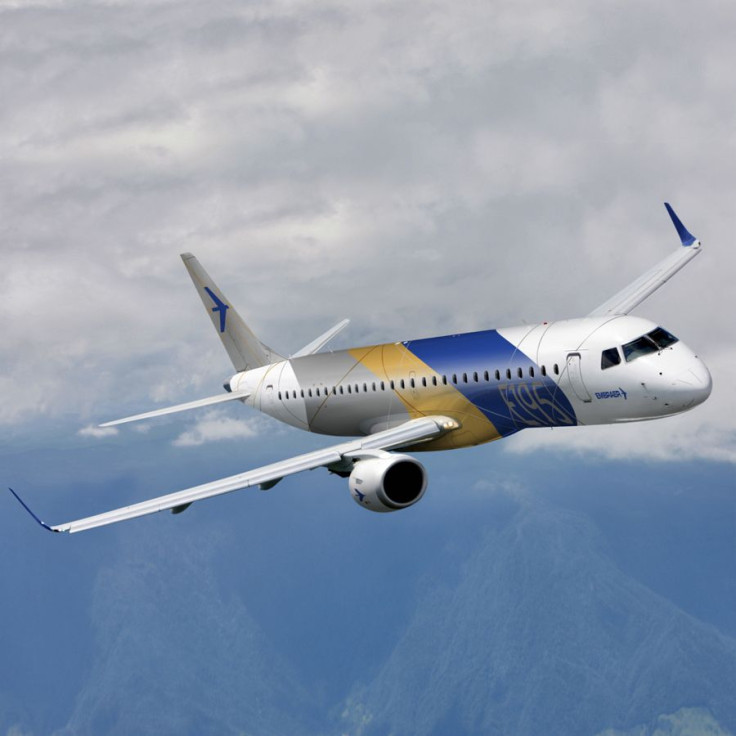Embraer's E195-E2 Is Ready To Fly

For the second time in as many years, Embraer (NYSE:ERJ) has a new commercial jet that is ready to enter service on time and on budget -- and with better-than-expected performance.
On Monday, the Brazilian aerospace company announced that regulatory authorities in Brazil, the U.S., and the EU had simultaneously certified its E195-E2 jet for commercial service. This clears the way for Embraer to deliver the first E195-E2 to Brazil's Azul this summer. Now, the focus will turn to Embraer's efforts to land some bigger customers for its biggest and most efficient jet.
All hopes rest on the E195-E2
Embraer began developing its E2 family of jets back in 2013, in order to keep up with new and upgraded models from Bombardier, Airbus (NASDAQOTH:EADSY), and Boeing (NYSE:BA). The E2-series jets are upgraded versions of Embraer's popular E-Jets lineup. But while they feature state-of-the-art, more efficient engines, Embraer did more than simply "re-engine" its existing models.
Most notably, Embraer designed new wings for the E2 models to improve their fuel efficiency and range. It also stretched the E195-E2 by three rows relative to the old E195 model, which was too close in size to the smaller E190 to sell well.
As a result, Embraer had recently advertised that the E195-E2 would burn 24 percent less fuel per seat than the E195. On Monday, the company revealed that the jet had beaten its specifications and will burn 25.4 percent less fuel per seat than its predecessor. It will also be 20 percent cheaper to maintain, can fly up to 600 nautical miles further, and performs better on short runways. The extra seats mean that pilot productivity will be higher, as well.
These features have helped make the E195-E2 the top seller among Embraer's next-generation models. As of the end of last year, Embraer had booked 111 firm orders for the E195-E2, compared to just 47 for the E190-E2, which is less attractive due to its higher unit costs. Furthermore, it doesn't have any firm orders for the E175-E2 (the third new model). So-called "scope clauses" at the major U.S. airlines have prevented their regional affiliates from upgrading to the E175-E2, which is slightly larger and heavier than the first-generation E175.
There's no sign that the scope clause issue will be resolved anytime soon. Meanwhile, there is a limited market of airlines interested in a plane of the E190-E2's size. That means the E195-E2 model may be the key to the success or failure of the entire E2 lineup.
Hunting for more customers
The E195-E2 has struggled to compete against the larger Boeing 737 MAX and Airbus A320neo-family narrowbody jets. John Slattery, who heads up Embraer's commercial aviation division, has argued that many markets don't have enough demand to support a 737 MAX or A320neo, and that it would be more profitable to fly an E195-E2 there. However, most airlines have been captivated by the lower unit costs of the larger Boeing and Airbus models.
Among those airlines that have recognized the need for a smaller aircraft type, the Airbus A220 (formerly known as the Bombardier CSeries) has attracted more demand than the E195-E2.
The E195-E2 is in between the two A220 models in terms of size -- seating 120 in a typical legacy carrier configuration -- and has roughly comparable unit costs. So it certainly ought to be competitive. Slattery stated earlier this year that he would be disappointed if Embraer fails to land a "marquee" customer before year-end. He has previously singled out U.S. carriers such as United Continental and Spirit Airlines as good fits for the E195-E2.
Embraer still stands to profit from success
Some investors might wonder whether the E195-E2 really matters much to Embraer anymore. After all, Boeing is set to buy an 80% stake in Embraer's commercial aviation business later this year. That means Boeing will get the lion's share of the potential profit if the E195-E2 jet eventually becomes a hit.
That said, Boeing has a market cap of more than $200 billion, whereas Embraer's market cap currently sits at just $3.5 billion. Moreover, Embraer expects to pay a special dividend of about $1.6 billion after closing the Boeing deal. Adjusting for that expected payment, its market cap is less than $2 billion.
For comparison, Embraer estimates that its 20 percent stake in the commercial aviation joint venture could be worth $1.5 billion, including the synergies from working with Boeing. Obviously, the more successful the E195-E2 is, the higher that value could go.
Thus, Embraer still has plenty to gain if the E195-E2 and its other new models succeed in the market. Investors should keep an eye on Embraer's progress in lining up additional orders for its new jets over the course of 2019.
This article originally appeared in The Motley Fool.
Adam Levine-Weinberg owns shares of Embraer and Spirit Airlines. The Motley Fool owns shares of and recommends Spirit Airlines. The Motley Fool has a disclosure policy.



















